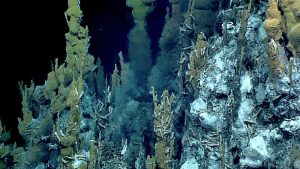
The more we explore our own planet, the more weird places we find life. From colonies growing up around deep ocean hydrothermal vents to microbes living in the soils revealed in deep Earth mines, over and over we keep finding that wherever we explore, life has found a way.
These discoveries have forced us to update our understanding of what it takes for life to exist. Once we thought the list was water, sunlight, and food. Today, we know reality is a bit more flexible. Sure, water is good, but we now think any chemical solvent will work. While my plants and I require sunlight, a lot of critters do perfectly fine in darkness; it turns out life needs a source of energy, and the Sun isn’t the only power plant around. Food is still required, but we’re learning that food can be any ol’ suite of molecules a lifeform can metabolize to move, grow, and thrive.
A solvent, an energy source, and nutrients… those are the real requirements for life, and they can be found on worlds far outside the habitable zone where liquid water can exist on a planet’s surface. It turns out that life in general is a lot less limited than life like ours.
Within our solar system, the most likely other places for life aren’t actually planets like Mars. While it’s possible subsurface moisture and molecules may support microbial life, this kind of existence isn’t what many of us are hoping for. The real exciting places to look are the currently impossible-to-reach oceans on worlds like Europa, Enceladus, and even Pluto. Beneath thick icy shells, each of these worlds is home to vast oceans of liquid water. On Pluto, the volume of liquid is even greater than the volume of habitable soil, air, and water we have here on Earth!

So, solvent, check.
In trying to understand if nutrients are present, we have to try and take a book by its cover or at least a world by its covering. The Cassini mission, which orbited Saturn, was able to observe geysers spraying material out of the ice shell of Enceladus. This material generally falls back down to the surface or escapes Enceladus to fill the rings of Saturn, but in one lucky pass, the mission was able to grab a bit of this material to feed into its mass spectrometer. In a new paper published in Nature Astronomy, researchers led by Jonah Peter do a statistical analysis of the detected materials and piece together a more complete picture of what molecules would have been present. They find the literal stuff of life. From water, carbon dioxide, methane, and ammonia to hydrogen cyanide, acetylene, propylene, and ethane, they are finding the kinds of organic molecules associated with the formation of life.
As Peter explains, “The discovery of hydrogen cyanide was particularly exciting, because it’s the starting point for most theories on the origin of life. Life as we know it requires building blocks, such as amino acids, and hydrogen cyanide is one of the most important and versatile molecules needed to form amino acids.”
This means there are nutrients.
The fact that there is a liquid ocean beneath an ice shell tells us somewhere inside that world is a heat source, likely similar to the hydrothermal vents we have here on Earth.
And there it is — the triumvirate of solvent, energy source, and nutrients.
But that doesn’t mean there is life. We still have no idea how easy or common it is for life to form. If we find none or all or even just some of these worlds with oceans also have life, that will allow us to start to understand what is the probability of life forming. Even if only one in ten ocean-filled icy moons harbor life, that opens up a wide range of places in our universe where life could exist.

According to a new paper in The Astrophysical Journal by Lynnae Quick, computer models now make it possible to predict what worlds outside our solar system may have the combination of density, distance from their star, and other factors that allow them to have an ice shell over an inner ocean. Of the planets they have modeled so far, they have been able to find several candidates. As Quick explains, “Our analyses predict that these seventeen worlds may have ice-covered surfaces but receive enough internal heating from the decay of radioactive elements and tidal forces from their host stars to maintain internal oceans. Thanks to the amount of internal heating they experience, all planets in our study could also exhibit cryovolcanic eruptions in the form of geyser-like plumes.”
Put another way, they have found seventeen worlds that may act like Enceladus and could support the kind of life that is found around Earth’s hydrothermal vents.
We live in a terribly frustrating time. We know there are worlds capable of supporting life. We don’t know if they do support life. And we can’t, yet, create machinery capable of cutting through the ice shells of worlds like Europa and Enceladus and seeing what life may lie beneath.
The best we can do is hope to capture droplets shot up in geysers and detect amino acids and maybe even DNA using orbiting spacecraft. According to new finding presented in the Proceedings of the National Academies of Science, researchers led by Sally Burke have shown unambiguous laboratory evidence that amino acids transported in these ice plumes can survive impact speeds of up to 4.2 km/s, supporting their detection during sampling by spacecraft. This kind of sampling and detection just might be possible by the Europa Clipper after it reaches Europa in 2030.
Science is a long game. A terribly frustrating long game.
Hopefully, in my lifetime, we will know just how common life is in our solar system, and we can begin to dream of intelligent life out beyond our solar system.
